Kamaret Camera
Blair Camera Company
| Name: | Kamaret |
| Manufacturer: | Blair Camera Co. |
| Country of Origin: | USA |
| Construction: | A leather covered wooden box camera, with the rollfilm holders in front of the focal plane. See description below. |
| Production Period: | 1891 to 1892? |
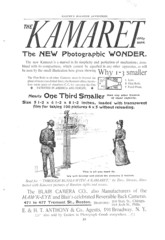 |
The Blair Kamaret introduced a significant design change. It is the first America box camera to have the film spools positioned at the front of the camera, in front of rather than behind the focal plane. This made the camera about one third shorter than the more conventional designs of that period. It was introduced to compete with the increasingly popular Kodak cameras of the period, notably the No 4 Kodak, but its popularity was limited due to legal action taken by Eastman Kodak (see Notes). This design feature and its benefits was proclaimed in advertising of the period. The full page advert shown here is taken from Harper's Magazine of May 1891, introducing the camera as "The NEW Photographic Wonder". Click on the thumbnail image to open a full size version in a new window. |
 |
| Plate / Film Size: | 4 x 5 roll-film |
| Lens: | Rapid Rectilinear |
| Shutter: | Two speed and timed exposure |
| Movements: | None |
| Dimensions (w x h x l): | 5½" x 6½" x 8¾" |
| Date of this Example: | c1892 |
| Serial Number: | Number 1552 written in pencil on the inside of each section of the camera and repeated on the removable film bed, but no external serial. |
| Availability: |
|
| Inventory Number: | 496 |
Description
This example of the Kamaret camera is in very good cosmetic condition, and came into my hands from an American collector. The leather covering of this example is in very sound condition, with no significant damage or wear. It came complete with its original lens plug. It carries a name plate on the inside of the fold down lens panel identifying the maker as "Blair Camera Co.". This example is set up for film use only, although a plate accessory back was available (see further notes below). At the time it was introduced (1891) the Kamaret was claimed to be about one third shorter in length than other equivalent cameras due to the film roll and transport being housed in the body in front of the film plane rather than behind it.
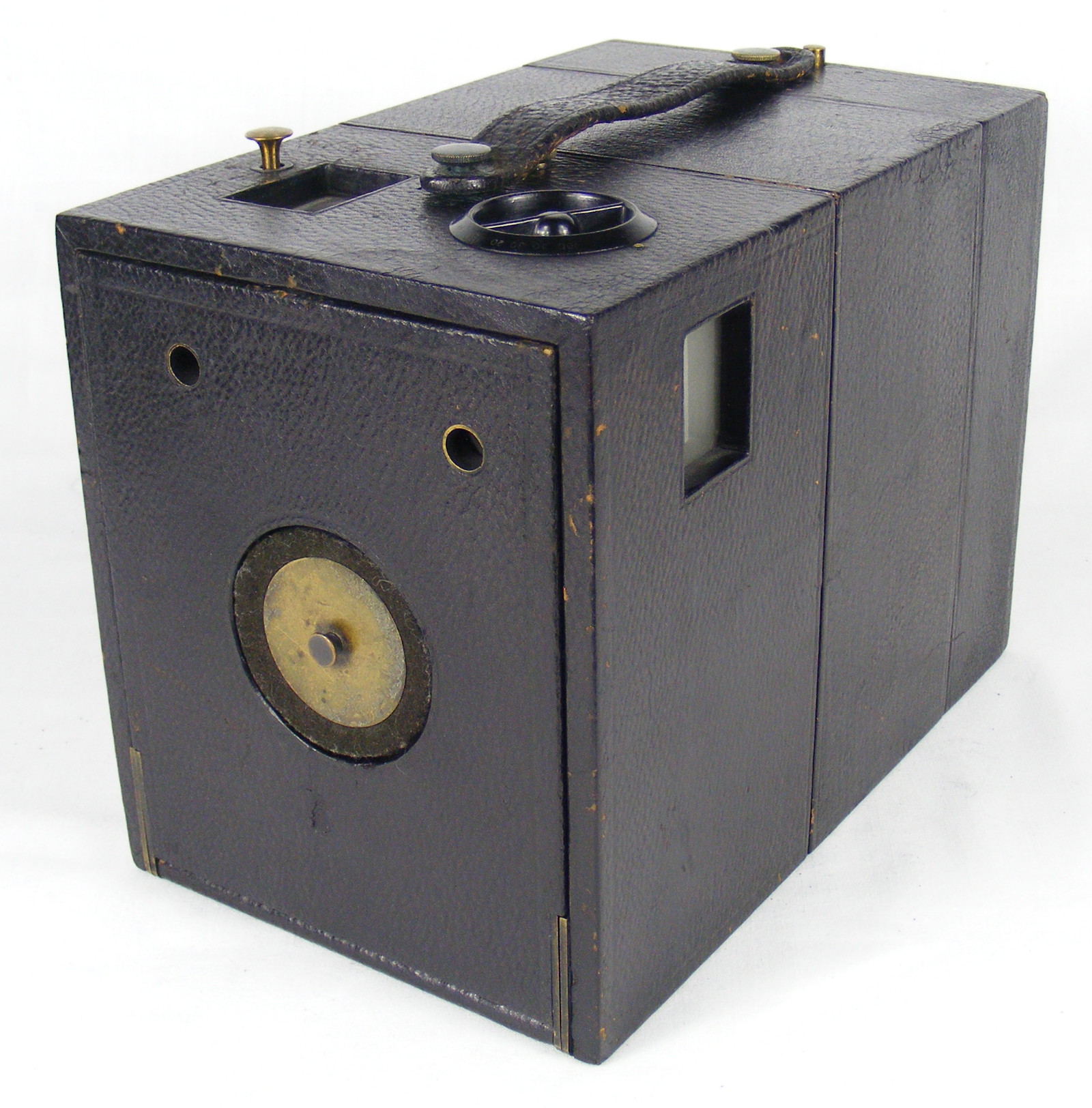
It was necessary to load the Kamaret's rollfilm in a darkroom, as with early Kodak cameras. This could be achieved by returning the loaded camera to Blair or the dealer from whom it was purchased where they would remove the exposed film and load a new roll before returning the freshly loaded camera, using a wooden shipping crate. Instructions were also provided so that the user could complete the operation themselves. The camera could be loaded with film for 25, 50 or 100 exposures. The complexity of loading and unloading the film was apparently a factor that worked against the popularity of the camera [13].
Note that the camera does not have a red window (not introduced until later) and instead has a narrow vertical slot in the rear body of the camera on the right hand edge that can be opened to examine the film as it passes through the back between the spools. The film itself was perforated between each of the exposures, allowing the photographer to identify when the next exposure was correctly positioned.
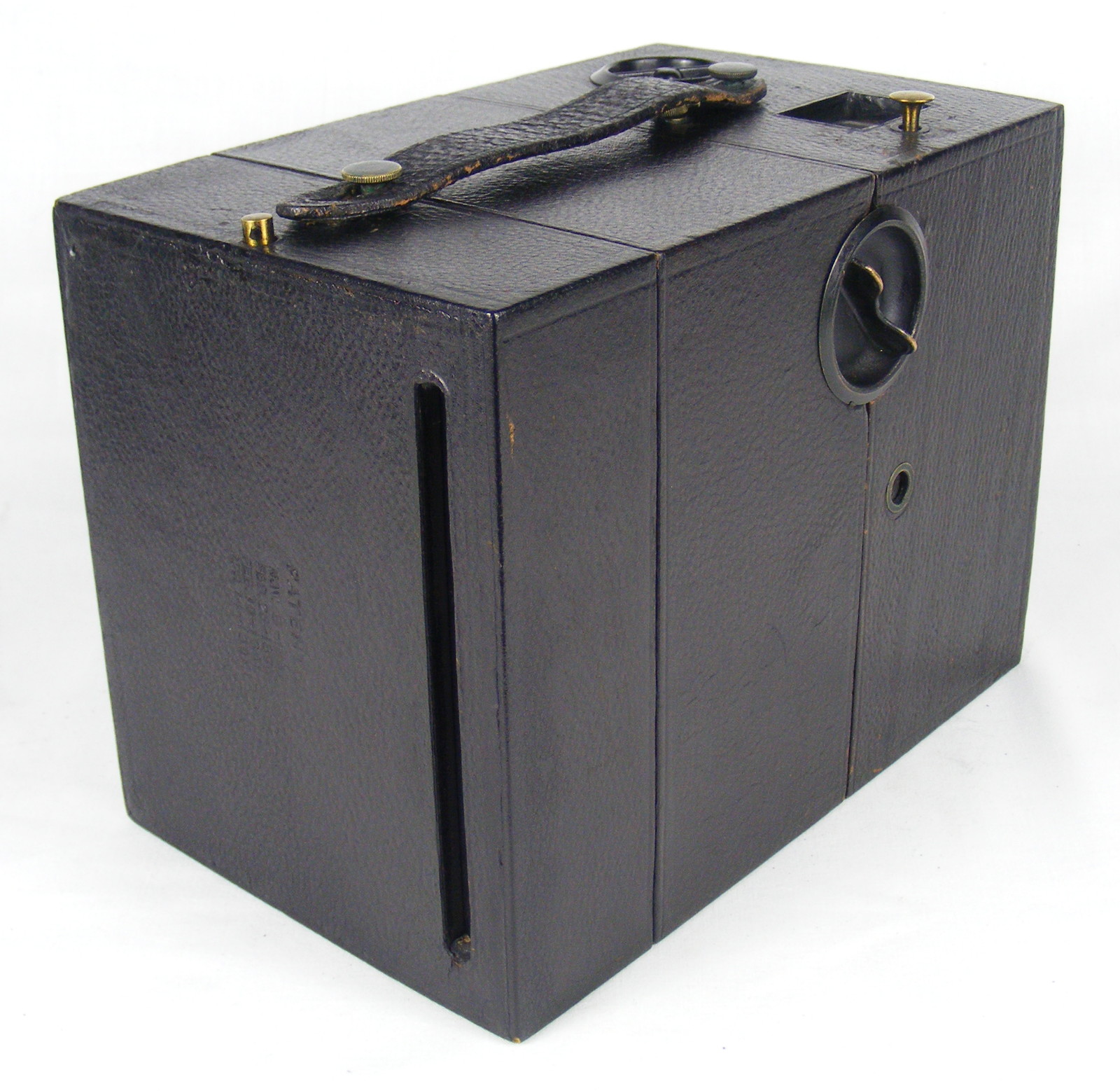
The shutter works intermittently on this example; it is prone to jamming when being set. To set the shutter, the brass capped shutter release has to be pulled up as far as it will go. After letting it return to its resting position, the shutter is fired by pushing on the same button. The lens has some obvious separation around its edge. It is marked 'Pat Dec 9 - 1890' and Front Lens, with a number 4. According to Eaton Lothrop, A Century of Cameras [5], the Rapid Rectilinear lenses normally supplied with the cameras were made by Darlot in Paris and supplied by Benjamin French & Co in Boston.
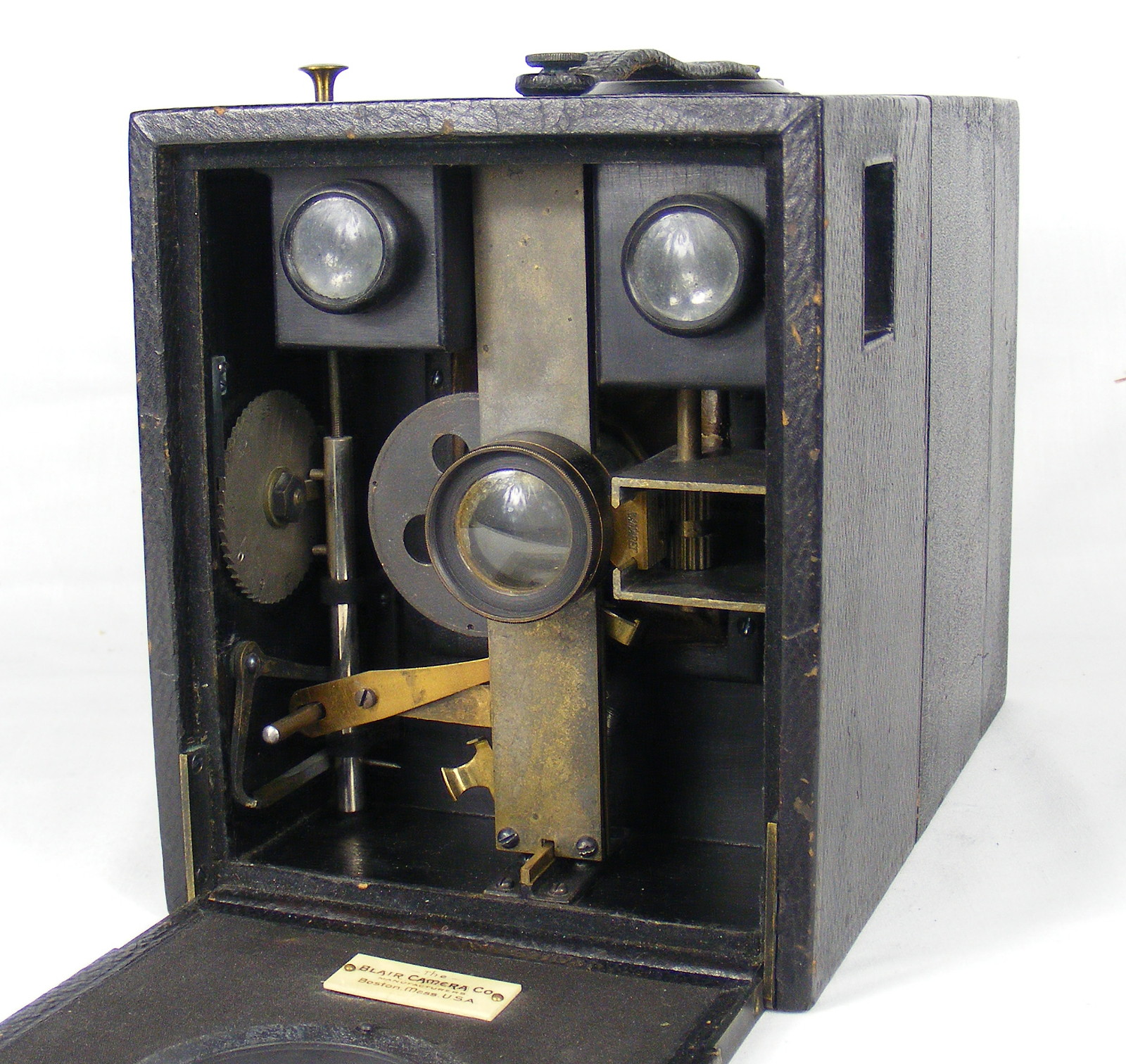
The camera body separates into three distinct sections, although to access the film, the rear and middle sections can be removed as one unit. The rear section can be replaced with a plate holder, available as an option. There is an inspection stamp and the number 1552 is written in pencil on one side of the inner body shell. The number 1552 is repeated on the inside of both the other component sections, and I have therefore assumed it to be the serial number. The date on the inspection stamp, where the "189" element of the date is pre-printed as part of the stamp itself, appears to be "7 - 15 1892" but the date is difficult to read with certainty.
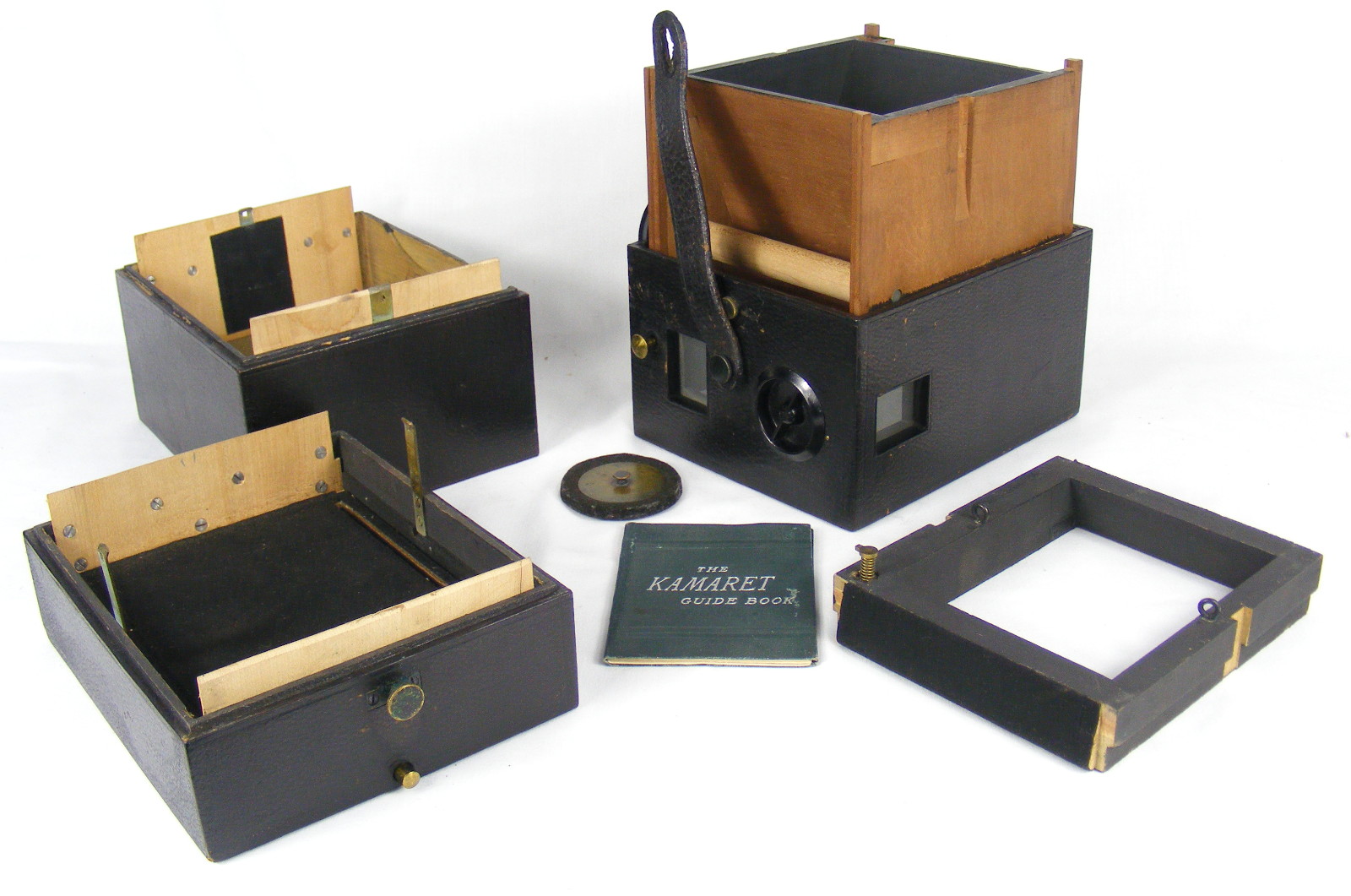
The camera incorporates a novel way of assisting the photographer to know when the film has been advanced to the next frame. When the shutter is set, the sprung shutter release operates a hinged lever that then pushes a square push rod that passes through the body of the first section of the camera. This rod in turn pushes on a sprung pointer mounted in one corner of the removable film bed. This action punches a small hole in the waste edge of the film. Opening the slot in the back of the camera by pushing the small brass button just behind the handle allows the hole to be seen. The user then winds on the film until the hole perforated into the waste edge of the film travels from the bottom to the top of the slot, knowing then that they have wound the film on by one frame.
The photo below shows the front half of the camera (upside down - note the tripod bush) and the removable film bed, that in use would sit on the back of this section of the camera. At top left of the camera body is a square recess. The push rod comes all the way through the sidewall of the camera body to this point and when actuated by setting the shutter, acts on the sprung pin built into the film bed that you can see at bottom left. When the film bed is in place, the sprung pin sits in the square recess. Curiously the film bed is attached to the body by a simple hook-and-eye arrangement on each side.
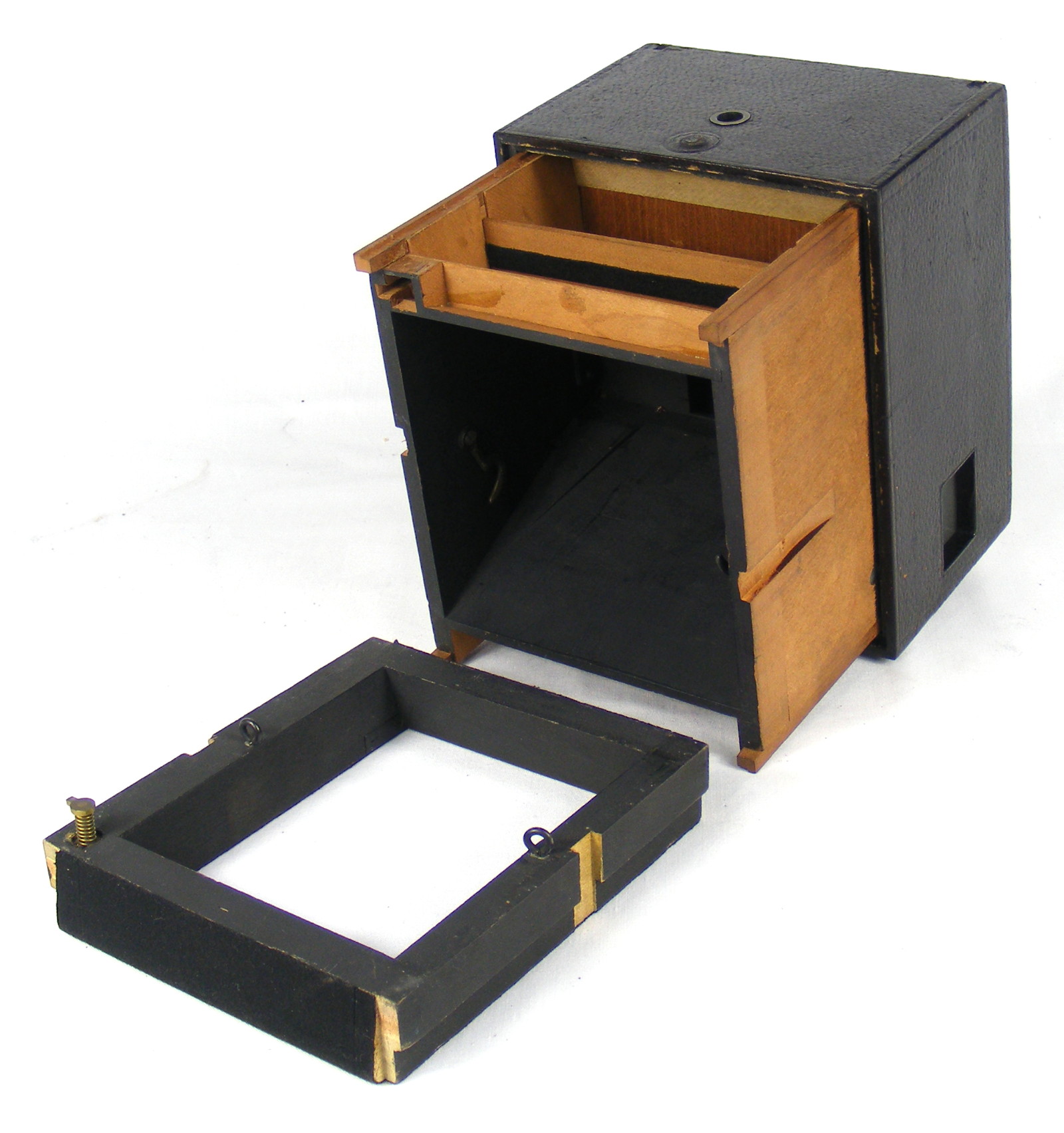
The shutter actuator performs a section function when setting the shutter. When it is pulled up to set the shutter, it causes the exposure counter to advance by one. The counter is the toothed wheel mounted on the inside wall of the shutter housing.
The original instruction booklet "The Kamaret Guide Book" is in good condition (dated 1891) - quite a rare find in itself. The booklet has green boards, 24 pages some of which are separating from its string binding; it is sized at 3" x 4" approx. Click on the image to open a pdf scan of the full booklet. It describes how to operate the camera, and how to remove and load film, and therefore how to separate the components.
The design of the Kamaret was based on patents then owned by, or licensed to, Blair that were to lead to legal arguments with Eastman Kodak (see Notes below). The Kamaret was intended to compete with the Kodak String Set cameras.
There are four US patents identified by date that are stamped into the leather on the back of the camera. Unfortunately when the die was applied to impress the dates into the leather, it was done so unevenly, meaning that the final two digits of the year are largely illegible. However, if true to form they will be listed in date order, the oldest first. The four patent dates listed are Nov 8 18??, Feb 25 1890, Feb 10 1891, and Apr 14 1891. I was able to confirm the full date for the middle two as they are quoted in a marketing brochure for the Kamaret dated 1891. I am still trying to identify the actual patents that each of these relate to. The only one I have been able to identify with confidence is the last (Apr 14 1891), which is US patent 450214 filed by Blair and Cromwell relating to the film puncturing device to aid the user to determine how far to advance the film.
Two later US patents both dated Feb 14 1893 and filed by Blair & Kelley describe the camera (491920) and shutter (491921) respectively in detail and are a useful reference source.
The rollholder used in the 4 x 5 version, as described on this page, was sufficient for up to 100 exposures (the same as the original Kodak); the larger 5 x 7 size could load 25 or 50 exposure film. According to the book by William and Estelle Marder on the history of the Anthony company [13], who had a trading arrangement with Blair and advertised the Kamaret, there was also a Petite version for pictures 3½" square, but I have as yet to see an actual example.
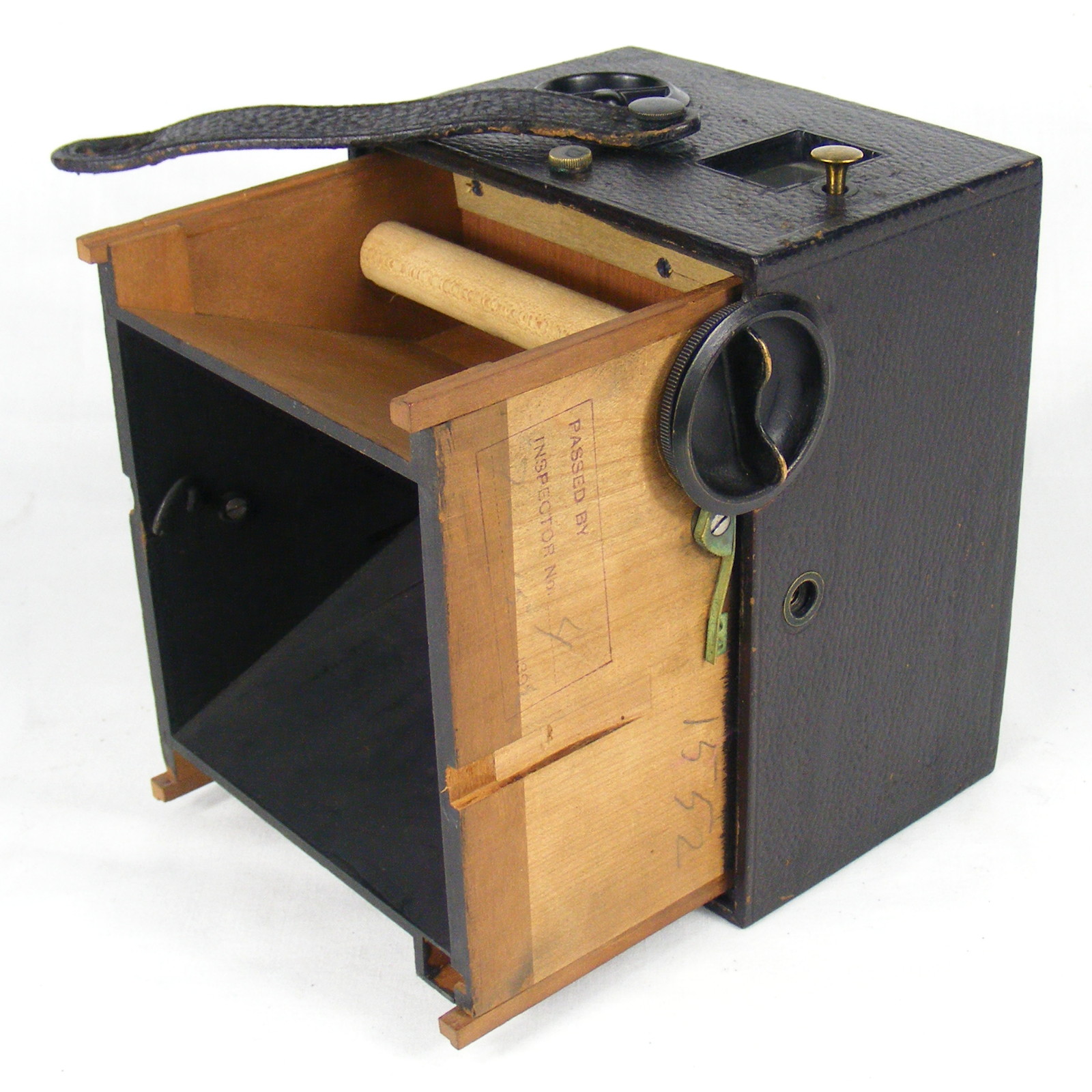
Given all the legal complications surrounding this camera, it is surprising perhaps to discover that the design did in fact undergo a significant change during the production cycle. The photo above shows the inner shell of the film carrier, with four wooden square dowels at each corner that project slightly to act as locating points for the removable film bed. In another variant of the camera, the wooden dowels are replaced by square brass rods, which are tapped at the end. When the case components are assembled they are held in place with four thumbscrews that pass through the camera back to engage with the end of each brass rod. Another difference is that the front cover over the shutter housing is a push fit rather than being hinged, but otherwise the camera construction appears to be the same. The 1893 patent (491920) describes this pattern, but was originally filed in 1891, the year the camera was first released.
Examination of a camera with this alternate construction using the brass rods and the 4 screws that pass through the rear of the camera to fix the component parts together has proven without doubt that this is indeed an earlier variant of the design as it carries an inspection stamp that is clearly dated 1891. The photograph below, reproduced with kind permission of Pacific Rim Camera, shows the component parts of this earlier variant of the Kamaret camera.
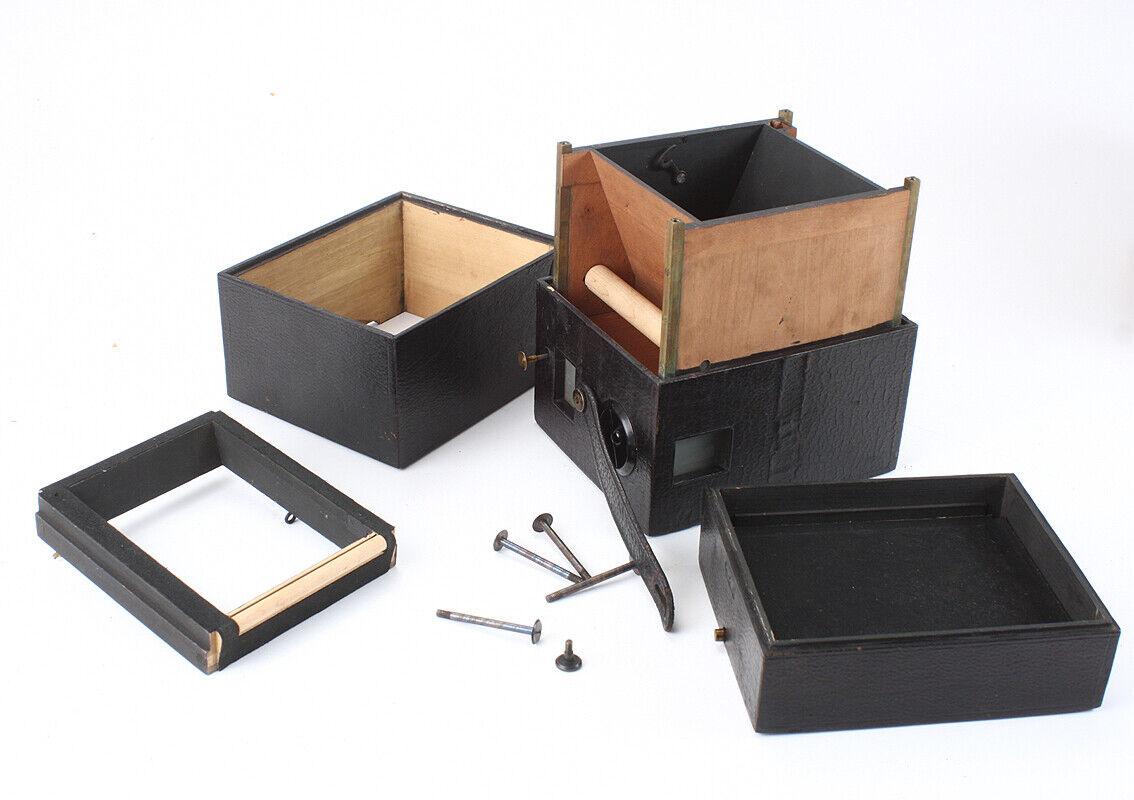
Eastman Kodak and Blair were caught up in legal argument after the introduction of the camera in 1891, which was only finally resolved in 1894 with the ruling going in Kodak's favour, as the court determined that the design of the Kamaret infringed other patents held by Kodak. Kodak advertising in this period had cautioned customers against purchasing any camera that appeared to copy the original Kodak. These factors are likely to have affected the popularity of the Kamaret camera at the time and therefore the number that are to be found today.
Notes
Blair's first venture into the photographic industry took the form of the Blair Tourograph Company, based in Connecticut, which produced the Tourograph camera and wet collodion system. The camera itself was made by the American Optical Company (part of Scoville). In 1881, Blair moved the company to 471 Tremont Street, Boston, Massachusetts and undertook his own manufacture of a re-designed version of the Tourograph intended for dry-pate use. The company was renamed at that time to Blair Tourograph & Dry Plate Company. E. & H.T. Anthony were acting as Blair's agent from some time in the 1880s.
The name of the company was shortened to Blair Camera Company in 1886. While various other cameras were manufactured in this early period, a turning point came when he joined forces with Samuel Turner, leading to Blair acquiring the Boston Camera Company in 1890 and with it the Hawk-Eye camera line. The Hawk-Eye Detective camera had been produced by The Boston Camera Company from about 1888, but was modified under Blair, leading to the manufacture of the Blair Hawk-Eye Detective that was to become a serious competitor to Kodak.
In the 1893 Blair managed to persuade business man and millionaire Darius Goff into becoming the major shareholder of the Blair Camera Company. The financial backing this provided allowed Blair to go on to design and launch other cameras, but also to start up a company in England to address the European market, following the same expansion pattern as Eastman Kodak. Samuel Turner left Blair's employ to form the Boston Camera Manufacturing Company, making cameras for Blair to sell through his European business based in London. One of the significant cameras that was to be produced by Turner in this period was the Bulls-Eye box camera that incorporated an innovative (and patented) red window in the rear of the camera, through which frame numbers could be seen on the paper backing on the rollfilm.
While a number of different cameras were produced in this period (consider the '95 Hawk-Eye or the Folding 5 x 7 Hawk-Eye), the Blair Camera Company went from profit to loss in the period between 1892 and 1894 [13, p277], influenced partly by the economic climate at the time but also seriously hampered by the various law suits with Eastman, including an injunction against the manufacture of the Kamaret. Blair's relationship with the board under Goff also soured. Things came to a head in 1895 when Blair left the company and sailed for England where he continued to sell cameras made by the Boston Camera Manufacturing Company.
In 1895, George Eastman bought out Turner in order to take control of his daylight-loading patent, although he was unable to get hold of patents for the rollfilm in front of the focal plane (patented by David Houston), the system used in the Kamerat, due to contractual complications arising from the way these had been licensed to Turner [14]. The sale of the Boston Camera Manufacturing Company to Eastman Kodak meant that Blair lost his supplier of cameras. In 1895, Blair returned to the USA and started up The American Camera Manufacturing Company, making cameras such as the Buckeye as well as other goods including film in order to supply to his European business.
In 1897, George Eastman agreed to buy the original Blair Camera Company from Goff who by then was making losses on his original investment, but Eastman also bought The American Camera Mfg Co from Blair. In purchasing both companies, Eastman Kodak secured a number of important patents, including the Houston patents and another held by the Blair Camera Company for a film with perforations that operated the film counter. Acquiring both companies very likely avoided significant ongoing legal costs arising from the patent disputes between the companies. It also allowed Kodak to adopt the Bulls-Eye name (as used for the No 2 Bulls-Eye Kodak) and the Hawk-Eye name, which was adopted across a variety of folding and box cameras such as the No 2A Folding Rainbow Hawk-Eye camera.
The sale of American Camera Mfg Co to Eastman Kodak seems to mark the end of Blair's involvement in the manufacture of cameras and photographic goods; he remained involved in manufacturing for a time but later in his life he would become a farmer. Thomas Blair died in Northboro, Massachusetts on April 4, 1919 at the age of 64.
The Kamaret turns up from time to time in the US market, but I have only ever seen the 4 x 5 size. The much larger 5 x 7 size is scarce. Irrespective of size, many of the examples that turn up are in rather poor condition - the leather covering is often quite worn and dry; examples in good condition often achieve quite high prices.
![[ ]](../../images/unchecked.png)
![[x]](../../images/checked.png)
